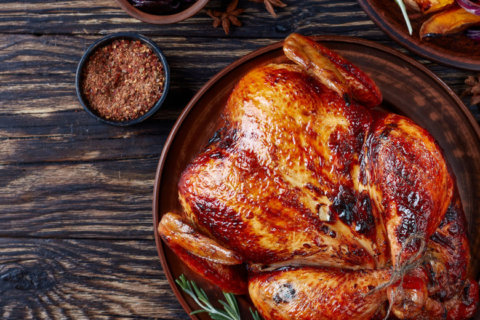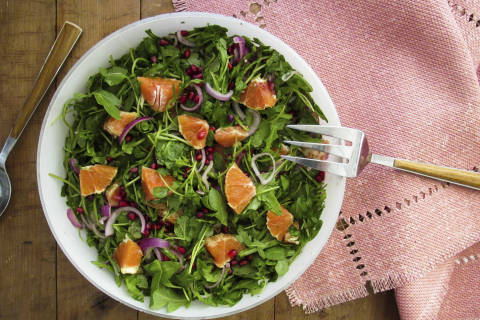WASHINGTON — Sam Sifton has advice for anyone who is on edge about cooking Thanksgiving dinner.
“First of all, let’s all just take a deep breath,” said Sifton, food editor for The New York Times and author of “Thanksgiving: How to Cook it Well.”
Yes, prepping and pulling off the annual feast is no small feat, but there’s no point in sweating anything — other than the onions.
“It’s one of America’s great holidays. We love it as a people with a passion, but it’s hard. And there’s some anxiety attached to it. And we need to radically accept whatever it is that’s going to happen on that Thursday,” he said.
Sifton says the best thing is to go into Thanksgiving clear-eyed and with a plan. Here’s his:
Avoid a dry turkey
Sifton says there’s a simple way to make sure the turkey you serve isn’t overcooked.
“The single most important thing you can do to achieve a good turkey is to get yourself an oven-safe digital thermometer that will tell you the interior temperature of the meat throughout the whole process of roasting the bird.”
When that number hovers around 160/162 degrees, take the turkey out and let it rest under a tent of aluminum foil for 30 to 40 minutes. Letting it rest allows the juices to set while the turkey comes up to the proper temperature.
“That’s a $20 investment that will pay off in years of perfect turkeys,” Sifton said.
There are other methods that can help to keep the turkey moist. One is to cut the turkey into pieces and cook the pieces in a pan with a little bit of braising liquid — whether it’s wine or stock.
“This will allow the top, the skin, to become very crisp, but that intensely moist atmosphere will help keep the meat quite moist,” he explained.
And while the jury is still out on whether basting keeps the turkey from becoming too dry, Sifton says it doesn’t hurt.
“Basting is, I think, as much about ritual as anything else,” he said, adding that pouring the juices and melted fat back over the bird is “a terrific way of ensuring that you have a really nicely burnished skin when you’ve completed the process of cooking it.”
There’s no need to drown your turkey in olive oil and butter. In fact, Sifton starts the cooking process with just salt and pepper on top and a little bit of butter under the skin, along the breast.
The turkey should be dry before it hits the heat; Sifton cranks the oven to 450 degrees for the first half-hour. The initial high heat causes the skin to tighten, almost like a “blister” around the rest of the bird, he explains.
“I’m not losing a lot of juices and I’m not wasting oven heat trying to evaporate water. I’m going straight to crisp skin, and then I’ll lower the temperature after a half-hour,” Sifton said.
Stuff your face, not the bird
Some eaters are very particular about a popular Thanksgiving side dish and whether it’s cooked inside the turkey or in a separate dish. Sifton is a fan of dressing, not stuffing, which he says interferes with the turkey-cooking process.
“Filling the bird with bread stuffing slows down the cooking process; it takes longer to cook it, and you don’t get a lot of stuffing out of it, either,” he said. “So I like to keep the cavity relatively free of debris.”

However, he does advise throwing some salt and pepper inside the bird to keep it seasoned. Occasionally, he will add onion or citrus slices in the turkey cavity for flavor.
“But not much. I like some hot air to be able to circulate on the inside of the bird and continue cooking at a relatively rapid pace,” he said.
Don’t worry about adding a “nontraditional” dish to the spread
This year, Sifton and a team of reporters at The Times set out to learn what’s on people’s Thanksgiving tables across the country.
“The overwhelming response is, ‘Oh we have a pretty traditional Thanksgiving,’” he said.
But it turns out “traditional” doesn’t mean the same thing to everyone. People from different countries and cultures all over the world incorporate flavors from those cuisines into their Thanksgiving spreads.
The feature profiles a Midwesterner who has a staple dish that is German red cabbage with red wine and apples, and a Jamaican woman who prepares jerk-spiced turkey.
Sifton’s point: If you’re itching to try that Peking-style roast turkey, go for it.
“I am just marveling this year at what traditional Thanksgiving really means to each and every one of us as Americans,” he said.
‘Double-down’ on the gravy
Thanksgiving is a once-a-year dinner. Despite turkey sandwiches being a popular lunchtime order at the deli counter, most people don’t roast turkeys at home except for that fourth Thursday in November. And Sifton says even less common than turkey throughout the year is gravy.
“The gravy experience is one that is really specific to Thanksgiving,” he said.
And that is why he likes to make it — a lot of it. In fact, he allocates one gravy boat to every few people at the table.
“It’s the substance that binds the whole meal together in my view,” he said.
Sifton makes his gravy from the drippings in the bottom of the roasting pan. (Tip: Farm-raised turkeys produce more fat, and thus more drippings, than the conventional birds sold in the grocery store.)
He whisks in a little flour to the fat (Sifton uses the brand Wondra, an instant flour that won’t leave lumps) and then a liquid or two, such as stock or cream, and some salt and pepper.
“And that’s a pretty good gravy every time. It tastes intensely of turkey and salt and fat and cream — and that’s Thanksgiving,” he said.
When it comes to dessert, more is better
Thanksgiving is all about indulging — and that doesn’t stop at the mashed potatoes. Sifton recommends having a variety of pies for dessert — apple, pecan, pumpkin, etc.— since guests like to sample a little of each.
“It’s not really about who has the best pie; it’s about which pie do you like best this year,” he said. “I think following through on the plenitude of the main meal during the dessert portion is absolutely important.”
Keep calm and cook on
On Thanksgiving Day, your kitchen is your safe place, so keep the guests out.
“Don’t give out kitchen tasks if your kitchen is small or if you feel someone is going to come in there and metaphorically upset your apple cart. Do your work in the kitchen,” he said.
And no matter what, maintain peace at the table. After all, the people you’ve surrounded yourself with are family and friends.
“Remember that you’re not going to change anyone’s mind, behavior, personality, political stance on Thanksgiving. It’s just not going to happen,” Sifton said.
“It’s a really marvelous day and I think it’s a good time to put aside our differences and just eat a lot of turkey and then fall asleep on the couch.”







